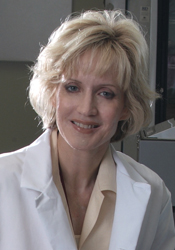Date/Time
Date(s) - 21 Mar 2013
12:00 PM - 1:00 PM
Location
The Biodesign Institute at ASU

Cheryl A. Nickerson, Ph.D., Professor of Life Sciences, Center for Infectious Diseases and Vaccinology, The Biodesign Institute, Arizona State University
“3-D Tissue Engineering Under Low Fluid Sheer Forces: Predictive Human Surrogate Models to Probe the Links Between Cell Function and Disease” – Cheryl Nickerson
Date & Time: March 21, 12 p.m.
Title: 3-D Tissue Engineering Under Low Fluid Sheer Forces: Predictive Human Surrogate Models to Probe the Links Between Cell Function and Disease
Summary:
Appropriately simulating the three dimensional (3-D) environment in which organs and tissues normally function is necessary for development of in vitro cultures that realistically resemble in vivo tissues and organs. For these reasons, the availability of reliable, reproducible 3-D organotypic cell culture models are being increasingly exploited for the meaningful dissection of human disease mechanisms, including those with an inflammation-mediated etiology, like infectious disease and cancer.
My laboratory uses rotating wall vessel (RWV) bioreactor technology to culture cells under physiological low fluid shear conditions for the establishment of organotypic 3-D cultures of human cells and tissues that recapitulate key aspects of the structure and function of in vivo tissues. Our models range in complexity from those composed of a single cell type (monotypic) to complex multicellular co-culture models containing functional immune cells that recapitulate key aspects of the 3-D architecture and multicellular complexity inherent in the parental tissue in vivo. We have also incorporated cadaveric bioscaffolds into some of our 3-D models to further enhance their physiological relevance. We have shown that our 3-D models respond to infection with microbial pathogens and their toxins in key ways that reflect the infection and/or intoxication process in vivo, and which cannot be reproduced by traditional in vitro cell culture models. In addition, our 3-D models serve as faithful predictors of the human response to drugs/therapeutics. By culturing cells in the RWV, we have also driven tumorigenic and transformed cells toward a more normal differentiated phenotype.
Our establishment and characterization of a variety of 3-D tissues using RWV bioreactor technology and their practical application as human surrogate models for infectious disease research, therapeutic development, and regenerative medicine have provided specific examples of how the study of these fields can be advanced by using appropriate, biologically meaningful models, and hold exciting potential for applications to study tumorigenic mechanisms.
